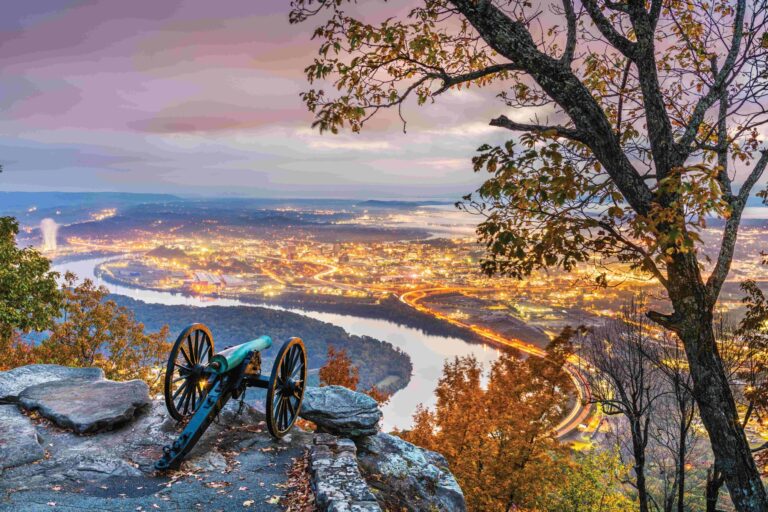If you take off from Chattanooga Metropolitan Airport-Lovell Field (KCHA) in Tennessee, and tell ATC that you are headed for Northeast Alabama Regional Airport (KGAD), the controllers are likely to know what you are up to.
Just as road trippers visit the area to drive scenic Lookout Mountain Parkway, pilots enjoy its stunning views from aloft, especially when the autumn colors are at their best.
If you’re not already a subscriber, what are you waiting for? Subscribe today to get the issue as soon as it is released in either Print or Digital formats.
The airport sits at the northern end of the parkway, which is made up of a number of county and state roads but generally parallels Interstate 59 in its 93-mile stretch across the mountain ridge between Chattanooga and Gadsden, Alabama.
The route is a dream come true for drivers who wish to escape big highways and travel the backroads. For pilots, the flight is an opportunity to brush up on navigating by landmarks and plan an airborne adventure that family members will enjoy and recall fondly for years to come.
The area is dotted with dramatic landscapes, interesting villages and towns, state and national parks and preserves, and other attractions that make it worth a visit regardless of the season.
Many will agree, though, that fall is special. For Northerners who have been meaning to explore the South by air, and might have missed the peak leaf-peeping period in their home states, Lookout Mountain offers a chance to span Alabama, Georgia, and Tennessee while catching spectacular fall colors.
The Airports
Climbing out from Chattanooga’s Class C airport toward Lookout Mountain for a flyover, you also are channeling the spirit of Johnny Green, a pioneer who thrived during aviation’s barnstorming infancy.
Green and the historic airport are linked because the pilot took John Lovell, a Chattanooga dignitary and the field’s namesake, for a demonstration flight in his fragile Curtis aircraft in 1912. The men took off from a rudimentary local airfield that preceded KCHA, and the experience solidified Lovell’s enthusiasm for aviation.
Lovell later became a member of the Tennessee Aeronautics Commission and the Chattanooga Chamber of Commerce. In 1927 he campaigned for a bond issue for construction of a new airport to replace its predecessor, Marr Field, which opened in 1919 and quickly became part of the growing airmail network. Difficult winds and runway conditions at Marr led Lovell and others to push for its replacement.
To promote the airport plan, Lovell arranged a visit by Charles Lindbergh to Chattanooga in 1927 and later brought World War I fighter ace and Medal of Honor recipient Eddie Rickenbacker to town. Captain Rickenbacker later became the president of Eastern Air Lines.
Lovell’s connections with such aviation luminaries helped seal the airport deal.
Lovell Field opened in 1930 with airmail service starting shortly afterward. In 1936 the airport was expanded and the runways paved as part of a Works Progress Administration project during the Great Depression. Its original terminal was built under the program as well, in classic WPA style. Passenger service started in 1937.
The field served as a training base for military pilots during World War II and was transferred to the city of Chattanooga during the 1950s as commercial aviation grew rapidly. The airport received a new runway during that period, and the terminal was expanded twice before a new building replaced it in 1964.
Northeast Alabama Regional Airport, formerly known as Gadsden Municipal Airport, opened in the mid-1940s and was providing airline service within a few years. Southern Airways, Atlantic Southeast Airlines, and Air New Orleans were among the carriers serving the airport during its early years.
While there is no major airline traffic at Gadsden today, due largely to the proximity of Birmingham-Shuttlesworth International Airport (KBHM), there are plans to further develop Northeast Alabama Regional to accommodate expanding operations of Alabama Air National Guard units based on the field. The airport is also home to the Warbird South Flying Museum, which promotes the preservation of vintage military aircraft and hosts community outreach events such as fly-ins and drive-ins for collector cars.
Other Fields
As you fly between Chattanooga and Gadsden, you can easily spot more than a dozen airports.
These range in size and character from well-established GA airports with paved runways of 5,000 feet or more to small, private turf strips that blend so well with their surroundings that they can be difficult to discern. Among the former are Barwick Lafayette Airport (9A5), Isbell Field (4A9), and Guntersville Municipal/Joe Starnes Field (8A1).
Many of the fields in the Lookout Mountain area are privately owned and require permission before landing. Some are as long as 2,000 feet, which could open the door to more than just hardcore STOL pilots. The combination of beautiful surroundings and intriguing names make them hard to resist.
After all, who wouldn’t want to visit Hogjowl Airfield (GE11) or learn more about a field called Headquarters (AL27).
Special Airspace
Arguably the most interesting spot in the area is Lookout Mountain Airport (0GE3) in Trenton, Georgia.
The private field is the home of Lookout Mountain Flight Park, a flight school and hub for the hang gliding community since 1978. More recently the operation added paraglider training.
If you call to request permission to land your Skylane at Lookout Mountain, the answer will be “no,” according to a spokesperson for the school. It is not that it does not enjoy visitors but that the steady stream of low-time student hang glider pilots landing on the 2,000-foot grass strip means the arrival of a larger fixed-wing powered aircraft would be a potential hazard to the hang gliders and paragliders using the field.
Because 0GE3 is just southwest of Chattanooga’s Class C airspace and an easy drive, visiting pilots should consider renting a car and driving to Lookout Mountain for a visit. You might wind up adding hang gliders to your list of ratings.
Other Things to Do
There are countless options for sightseeing and activities on and near the parkway.
Highlights include Civil War history from traditional battlefield tours of Chickamauga and Chattanooga to the high-tech Battles for Chattanooga Museum. Both experiences bring history to life but in different styles.
The Lookout Mountain Incline Railway is a great way to enjoy spectacular views on the way up to the aptly named peak.
The railway climbs a 72-degree grade that is so steep, sightseers look forward through a glass roof of the trolley cars to see the scenery unfolding below. The railway is a National Historic Mechanical Engineering Landmark as well as a National Historic Site.
In contrast, tours of Ruby Falls take visitors underground to see the 145-foot natural subterranean waterfall and related formations.
Beautiful waterfalls and canyons are among the scenery at DeSoto State Park and DeSoto Falls, where visitors can commune with nature before retiring to rustic cabins, motels, or campgrounds for the night.
Little River Canyon National Preserve is known for its photogenic qualities. Visitors can drive the 23-mile route along the canyon and see into its 700-foot gorge.
The Little River Falls in Fort Payne, Alabama, off Highway 35 offers great conditions for canoeing, whitewater kayaking, rock climbing, and rappelling. Visitors can bring their own equipment or work with outfitters. Horseback riding is allowed in the preserve as long as you bring your own horse.
The ancient rock formations of Rock City, just a few miles outside downtown Chattanooga, present yet another spot from which to take in amazing scenery including views of seven states. Attractions including Fairyland Caverns and Mother Goose Village, and dining on traditional southern cuisine at Cafe 7 make this a full-day destination.
Should you consider staying in the Lookout Mountain area long-term, be sure to visit The McLemore, which is a planned community built around two world-class golf courses designed by well-known course architects Rees Jones and Bill Bergin. The development is located two hours by road from Nashville and Knoxville, Tennessee; and Birmingham and Huntsville, Alabama; and Atlanta.
A deep dive, or even a shallow one, into the Lookout Mountain Parkway would not be complete without mention of the World’s Longest Yard Sale, also known as the 127 Yard Sale, which follows the Highway 127 corridor from Addison, Michigan, to Gadsden. The event, which has been chronicled on who-knows-how–many YouTube channels, Instagram Reels, and vlogs, is a linear flea market with more than 5,000 vendors stretching 690 miles over six states.
The sale runs for four days in August, so folks have lots of time to plan for the next one. If you decide to fly in for the yard sale, you could rent a car at KCHA and start shopping. To avoid being overwhelmed, though, or overwhelming your aircraft’s useful load, you might limit yourself to cruising the 93 miles of cast-off commerce along the parkway and skip the trek to Michigan.
Because I am in a long-term decluttering mode, I have vowed to keep our Commander 114B’s baggage compartment clear of random tchotchkes. Such commitments are unlikely to detract from the joy of flying the Lookout Mountain Parkway.
This feature first appeared in the November Issue 952 of the FLYING print edition.




